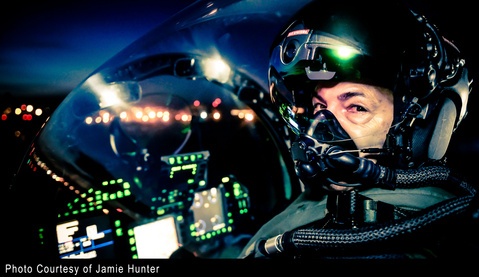New smart helmet allows fighter pilots to see in dark
17 Jul 2014
A new smart helmet that would allow fighter pilots to see in the dark via an integrated night vision camera was on display at The Farnborough Airshow.
The Striker II, built by BAE Systems, featured a visor which doubled up as a high-definition display, and projected useful information to the user including data about targets and the co-ordinates of objects below.
The helmet, boasting head-tracking technology, had been described as a "significant advance" by one expert.
Earlier generations of fighter pilot helmets had been fitted with exterior night vision goggles, which added to the overall weight on a pilot's head.
Striker II night vision camera does not protrude from the helmet. Analogue goggles could weigh as much as 0.5kg, which may not appear much, they became nine times heavier when the jet accelerated at 9G.
Goggles also changed a helmet's centre of gravity, which caused neck strain and restricted the pilot's movement during night flights.
The Striker II, built on its predecessor's "x-ray" display, moved night vision inside the helmet by using an image from a digital camera which was relayed through the helmet mounted display on the visor.
Night vision is vital to pilots when they are flying in close formation, mid-air refueling or assisting troops on the ground, and even launching a ground attack.
BBC quoted Chris Colston, director of business development at BAE, as saying, the first role of a helmet was still to keep pilots safe, but added Striker II also provided "all of the capability all of the time"
 The firm's new Striker II helmet-mounted display, which it launched yesterday at the Farnborough International Airshow, updated its earlier Striker model, which is being used by Eurofighter and Gripen pilots.
The firm's new Striker II helmet-mounted display, which it launched yesterday at the Farnborough International Airshow, updated its earlier Striker model, which is being used by Eurofighter and Gripen pilots.
Colston said the camera, the ISIE-11, supplied by Intevac Photonics, was already in use with the US Army. It offered a resolution of 1,600 x 1,200 pixels, and did not produce the halos seen with goggles or the bright points known as scintillations, he added.
According to BAE test pilot Mark Bowman, the elimination of heavy goggles from the equation was a blessing for pilots experiencing 9G's on the face. He added, the helmet was platform agnostic and free of ITAR trade restrictions.
BAE added, the new helmet also offered upgraded tracking that ensured the pilot's head and position and the aircraft's computer were constantly in sync with no delay, allowing for more accurate position of data on the visor.





















